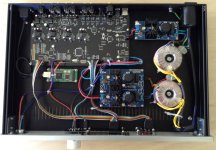badeff, you need to connect BCLK from JLSounds to Najda pin 23. BCLK in JLSounds is on pin 11, not pin 13. Just like your screenshot shows.
Also, your I2S wires seem very long. If they are more than few cm LVDS is better choice over IIS.
About the volume, you can setup the method of volume control in main menu of the device. Go to menu -> Volume control -> Wheel
badeff,
Just watched your video. This actually reminds me of identical issue I have had time to time using macbook. Just can't remember what was the cause. But I'm pretty sure if you use different software to generate the sweep you won't have the issue. With ARTA I never had the issue but with REW I did, but only occasionally. Also, IIRC, reloading najda setup helped. You could also check your macbook audio midi setup and try with different bit depth/frequency to see if anything changes.But when I played a test sweep tone 20-20000 from REW, there were very strange artifacts in the higher tones, from approximately 10 KHz and above — like howling wind, or repetitive echo.
Update - the culprit is found.
I double-checked the wiring with the guys from JL Sounds (we're lucky to live in the same city), they confirmed that it's correct, but had no clue where the artifacts might come from - and also suggested playing with the output bitrate, or trying the other I2S inputs.
After playing with various settings, it seems that that Najda's 192 KHz resampling is the problem. I have two active presets loaded now, with just basic two-way crossovers at 96 and 192. When started in 96, Najda plays the test tone without a glitch - from two different versions of REW, and from a WAV file. Once switched to 192, it starts adding loads of noise and artifacts in the high frequencies. Switching back to 96 - the noise is there again. But if the Najda is switched off in 96 KHz and restarted, all comes back to normal.
So, I'll simply ditch 192KHz modes, stick to 96 and save some computational resource. 🙂
Thanks a lot for the volume knob tip, Piisami! I got confused at the begining, as you have to go through several menu screens that are blank of full of garbled text, but I got it working now.
BTW, can someone tell what is the maximum depth/frequency supported by Najda? - I' can't find any clear info in the documentation. A couple of days ago I randomly played a hi-res file at 384 KHz, and the board went completely nuts. Only Core 0 was working and although I have only channels 1-2 and 5-6 enabled, all the 10 channels were active in the NUC monitor. Switching on and off several times didn't help - until I erased all presets, left the Najda with a simple 48 KHz passthrough, and rebooted again.
I double-checked the wiring with the guys from JL Sounds (we're lucky to live in the same city), they confirmed that it's correct, but had no clue where the artifacts might come from - and also suggested playing with the output bitrate, or trying the other I2S inputs.
After playing with various settings, it seems that that Najda's 192 KHz resampling is the problem. I have two active presets loaded now, with just basic two-way crossovers at 96 and 192. When started in 96, Najda plays the test tone without a glitch - from two different versions of REW, and from a WAV file. Once switched to 192, it starts adding loads of noise and artifacts in the high frequencies. Switching back to 96 - the noise is there again. But if the Najda is switched off in 96 KHz and restarted, all comes back to normal.
So, I'll simply ditch 192KHz modes, stick to 96 and save some computational resource. 🙂
Thanks a lot for the volume knob tip, Piisami! I got confused at the begining, as you have to go through several menu screens that are blank of full of garbled text, but I got it working now.
BTW, can someone tell what is the maximum depth/frequency supported by Najda? - I' can't find any clear info in the documentation. A couple of days ago I randomly played a hi-res file at 384 KHz, and the board went completely nuts. Only Core 0 was working and although I have only channels 1-2 and 5-6 enabled, all the 10 channels were active in the NUC monitor. Switching on and off several times didn't help - until I erased all presets, left the Najda with a simple 48 KHz passthrough, and rebooted again.
Well, I'll try relocate the XMOS board to the other side then, before building a final case for the Najda.I will not say it's the reason but for i2s you should use shortest wires possible. Better to add usb extension internally in the case, if you need it on back panel. like here for example
What I don't like in the picture is the USB connection between the board and the back of the case. A few years ago I made a small listening experiment with several generic USB cables and an entry-level audio grade USB interconnect, a Furutech Formula 2. Compared to it, all the generic cables totally killed detail and dynamics, producing a muddy and muffled picture. I'd say that the benefits of shorter I2S wires in this case would be annihilated by a crappy USB line feeding the board.
I do blind tests when I'm unsure of what exactly I'm hearing. In this case the difference was so obvious that no blindfolding was needed. 🙂
Another one insisting on actual reality. Yup... 🙂Oh no, another one.
"Oh no, another one." 🙂In this case the difference was so obvious that no blindfolding was needed. 🙂
I wish i could get $5 for each person who claims totally obvious differences in sighted listening but fails to hear them in a controlled double-blind test.
You could live with slightly longer I2S wires but then switch them to UF.L cablesI'd say that the benefits of shorter I2S wires in this case would be annihilated by a crappy USB line feeding the board.
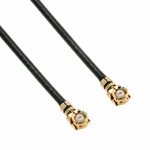
and for that you would need some custom pin to UF.L converter, similar to those.
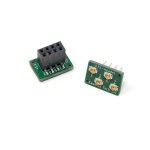
Sorry, I'm not cables believer. Too long I2S don't change sound quality, it leeds to transmission errors, breaks, cracks and whole lot of unexpected behaviour.
In original Najda Boxed, connection was done with additional optoisolator board.
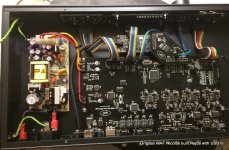
Anyway, before you boxed it you can make another set of shortest possible I2s cables only for test purposes and check if this fixes the problem
And another topic are your wires equally long? Those on left looks longer then green one, keep all wires same length, needed or no.
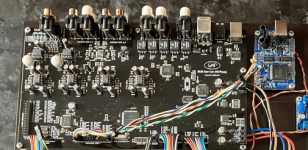
Last edited:
This ^Too long I2S don't change sound quality, it leeds to transmission errors, breaks, cracks and whole lot of unexpected behaviour.
Thank you Bacek, I'll check these out.You could live with slightly longer I2S wires but then switch them to UF.L cables
and for that you would need some custom pin to UF.L converter, similar to those.
That looks much better than the previous boxed version, indeed.Sorry, I'm not cables believer. Too long I2S don't change sound quality, it leeds to transmission errors, breaks, cracks and whole lot of unexpected behaviour.
In original Najda Boxed, connection was done with additional optoisolator board.
That's what I'm planning to try. And you're right - the green/black line is a bit shorter, I'll have to fix that.Anyway, before you boxed it you can make another set of shortest possible I2s cables only for test purposes and check if this fixes the problem And placing USB board on left side will require bit shorter wires for I2S
Thanks for your time - much appreciated!
I wish i could get $5 for each person who claims totally obvious differences in sighted listening but fails to hear them in a controlled double-blind test.
I'd have no problem in conducting a blind test once more, alone or with other listeners. But I doubt that would add any credibility for anyone outside the listening room.
I used to be very sceptical myself about digital cables making any difference, until I started comparing - but all of this is a topic for a different thread.
But dont check it when twisted. Untwisted/stright length needs to be the same.the green/black line is a bit shorter, I'll have to fix that.
This may have been covered somewhere else but my basic searches didn't reveal.
I am interested if connecting my Gustard U18 reclocker to Najda using I2S might yield better SQ than the Coax Spdif I currently use between the two?
The Gustard can output I2S over HDMI.
Can have 4 different output settings

Najda uses native I2S.

In the past I have used WaveIO for USB into Najda, and more recently RPi/Volumio + Kali reclocker feeding native I2S.
For I2S over HDMI
I will need a HDMI receiver board at the Najda end to translate the HDMI levels to raw I2S.
Would something like this do the job?
https://www.audiophonics.fr/en/interface-modules/hdmi-to-i2s-spdif-digital-interface-p-13415.html
This must have been done before?
Any recommendations on devices or views if SPdif is unlikely to be beaten?
I am interested if connecting my Gustard U18 reclocker to Najda using I2S might yield better SQ than the Coax Spdif I currently use between the two?
The Gustard can output I2S over HDMI.
Can have 4 different output settings
Najda uses native I2S.
In the past I have used WaveIO for USB into Najda, and more recently RPi/Volumio + Kali reclocker feeding native I2S.
For I2S over HDMI
I will need a HDMI receiver board at the Najda end to translate the HDMI levels to raw I2S.
Would something like this do the job?
https://www.audiophonics.fr/en/interface-modules/hdmi-to-i2s-spdif-digital-interface-p-13415.html
This must have been done before?
Any recommendations on devices or views if SPdif is unlikely to be beaten?
Gentlemen,
Yet another question from me:
Has anybody found a way to get volume control on SPDIF outputs?
I wanted to “upgrade” the Najda with two pretty good external DACs I’ve got sitting in the cupboard, but in the last moment realised that it’s impossible to control the volume with the stock board and firmware. Nick mentions that as an option for future updates in a post from 2012, but never got to it, obviously.
Regards:
Boris
Yet another question from me:
Has anybody found a way to get volume control on SPDIF outputs?
I wanted to “upgrade” the Najda with two pretty good external DACs I’ve got sitting in the cupboard, but in the last moment realised that it’s impossible to control the volume with the stock board and firmware. Nick mentions that as an option for future updates in a post from 2012, but never got to it, obviously.
Regards:
Boris
Hello Folks !
Najda Firmware speaking ...
By the past couple of years, I've made few tries to figure how to work of the Najda firmware, change it etc....
Do someone as already worked on it ?
Few years ago I was thinking that it could somehow hurt Nick's memory, but today I think more that Nick made this DSP for DIYers and in this current situation he probably would have been OK to let someone works on it.
I'm an IT/dev guy, but never worked on embedded firmware nor on firmware hardware needed, but if some'd like to work together it could be a fun project.
Najda Firmware speaking ...
By the past couple of years, I've made few tries to figure how to work of the Najda firmware, change it etc....
- From the ground, with the hypothesis, that the Najda onboard the necessary stuff to work directly on a firmware creation
- And also trying to analyse last firmware to find how to modify it.
Do someone as already worked on it ?
Few years ago I was thinking that it could somehow hurt Nick's memory, but today I think more that Nick made this DSP for DIYers and in this current situation he probably would have been OK to let someone works on it.
I'm an IT/dev guy, but never worked on embedded firmware nor on firmware hardware needed, but if some'd like to work together it could be a fun project.
In my opinion someone picking up the torch would not be construed as negative at all.Few years ago I was thinking that it could somehow hurt Nick's memory, but today I think more that Nick made this DSP for DIYers and in this current situation he probably would have been OK to let someone works on it.
- Home
- Source & Line
- Digital Line Level
- DSP Xover project (part 2)
